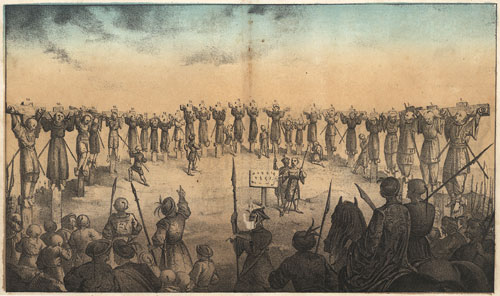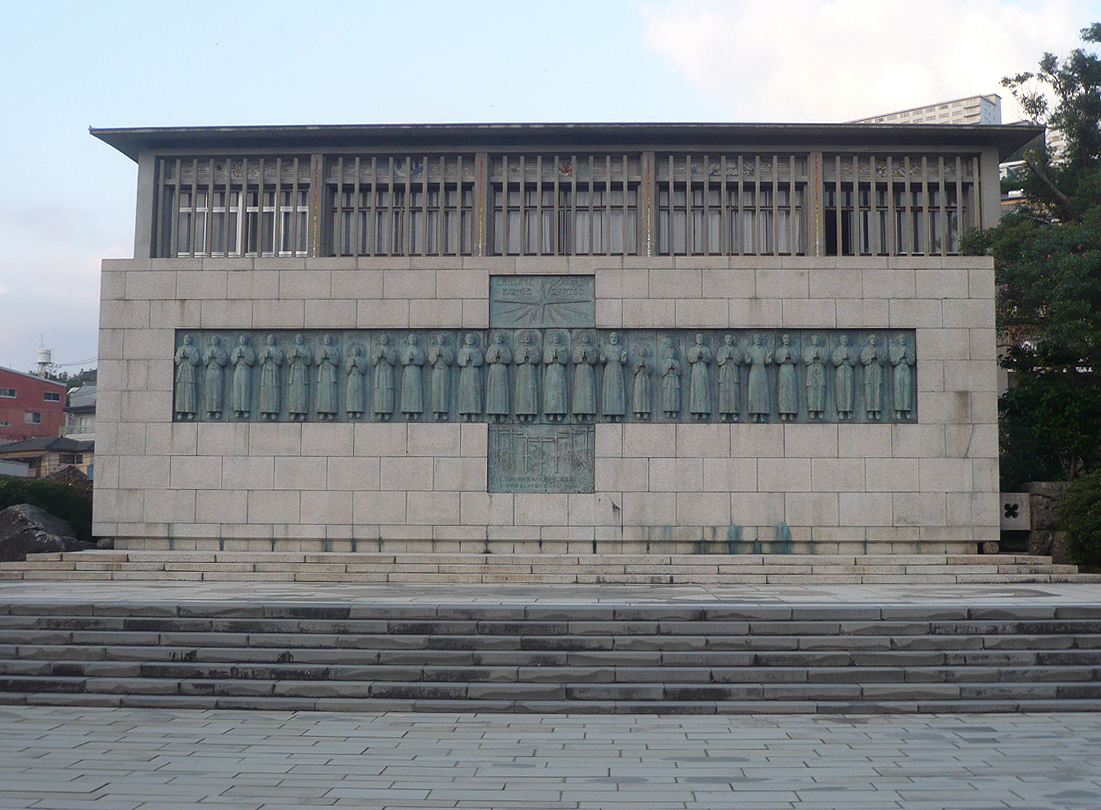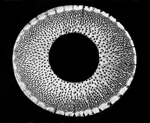
'Fukesō' = 'Komosō'
c. 1560?
|
Chronology
JAPAN 4 • 1560-1614
1560-1614 - THE AGE of the LATE KOMOSŌ: THE FUKE-SŌ
月次風俗図屏風 - TSUKINAMI FŪZOKU-ZU BYŌBU
"Screen with Genre Scenes of the Twelve Months"

Komosō playing a short vertical flute in a street (center)
Detail of section 4 of the folding screen
'Tsukinami fūzoku-zu byōbu'
"Screen with Genre Scenes of the Twelve Months"
Anonymous, late Muromachi Period (2nd half of 16th century). Tokyo National Museum


Do we actually see the komosō above wearing a long sword, possibly made of wood (?),
the tip of which is protruding from his left side, appearing just beneath the bed roll that he is carrying on his back?
Link to an online, inter-active website presenting the complete screen:
Tokyo National Museum - E-Museum online
c. 1550-1560
普化僧 - FUKE-SŌ synonymous with KOMOSŌ
コモ
僧
節用集 - SETSUYŌSHŪ DICTIONARY VERSIONS: Guides to Character Readings


Details from the 'Ryūmon bunko no Setsuyōshū'
Library of Nara Women's University - precise date unclear
When, approximately, did the komosō of Medieval Japan adopt Fuke Zenji as their idol of shakuhachi asceticism?
A few late Muromachi Period versions of the popular dictionary Setsuyōshū", "Economical Collection" or "Collection [of Words] for Everyday Use",
do actually present noteworthy evidence in that respect:

Readings for the kanji 'Komo-sō' and 'Fu-ke(-sō)'
in three different early versions of the 'Setsuyōshū'
- second half of the 16th century
In their comparative study of various early versions of the Setsuyōshū, Kamei Takashi and Takaha Gorō (1974) presents the table shown above (Vol. 1, p. 727):
1: Kuromoto-bon Setsuyōshū, c. 1550-1560.
The kana reading shown for both the kanji komo-sō and that of fu-ke is:
'ko+mo+so+u' - alt.: 'ko+mo'.
2: Tenshō jūhachinen-bon Setsuyōshū, Tenshō 18, 1590.
The kana reading shown for the kanji fu-ke-sō is:
'ko+mo+zo+u'.
3: Manjūya-shū Setsuyōshū, Keichō Period, 1596-1615.
The kana reading shown for the kanji komo-sō is:
'ko+mo+zo+u'.
Read more about the Setsuyōshū here: Wikipedia: Setsuyōshū
Link to the Nara Women's University Library manuscript database:
Ryūmon bunko no Setsuyōshū
1565-1576

Itinerant monk (?) playing a short vertical flute on a bridge
Detail of the folding screen 'Takao kanpu-zu byōbu'
By Kano Hideyori, act. 1565-1576. Tokyo National Museum

1560: Oda Nobunaga begins to eliminate his daimyō enimies.
One of the Jesuit missionaries meets with shōgun Ashikaga Yoshiteru in Kyōto. Yoshiteru issues orders that the missionaries are to be well treated and not taxed, and are authorized to work in Kyōto. By this time there are about 12 missionaries in Japan, most living and working on Kyūshū.
The Catholic Father Caspar Vilela makes Kyōto a center of Christian missionary work.
1566: The emperor, under pressure from the Buddhists, issues an order expelling Christian missionaries from Kyōto. They flee to
Kyūshū and Sakai.
1569: After a meeting with Nobunaga and Yoshiaki in Kyôto, Jesuit missionaries are allowed back in the capital to preach.
1568: Nobunaga takes control over Kyōto and soon breaks the resistance of the Buddhist monasteries.
1573: Nobunaga drives Shōgun Yoshiaki out of Kyōto, bringing an end to the Ashikaga Shōgunate.
1574 - RAKU-CHŪ RAKU-GAI ZU - Uesugi-bon edition

Komosō playing a vertical flute in a Kyōto street
Detail of the folding screen 'Raku-chū raku-gai zu byōbu',
"Pictures from In and Around the Capital",
Uesugi-bon edition. Commissioned by Oda Nobunaga.
The Yonezawa City Uesugi Museum, Yamagata Prefecture
1575: At the Battle of Nagashino, Nobunaga's troops are the first to use firearms: muskets, on a large scale - weaponry introduced in Japan by European merchants and missionaries.
1582: Nobunaga dies and his general Toyotomi Hideyoshi gains control. The are now about 200 Christian churches and around 150.000 Christian converts in Japan.
1582: A Japanese delegation is dispatched to visit the Pope in Rome.
1583: Toyotomi Hideyoshi commences the construction of the grand Castle of Ōsaka.
1584: A Spanish trading ship, blown off course in a storm, enters Hirado. Because he is jealous of Nagasaki's monopoly with Protuguese traders and he dislikes the Jesuits, Matsuura, the daimyō there, welcomes it and agrees to receive other Spanish traders and non-Jesuit missionaries in Hirado if they wish to come.
1584: Hideyoshi occupies Kyōto and enters an alliance with the powerful Tokugawa Ieyasu.
1585: Hideyoshi brings Shikoku under control and becomes Imperial regent, Kanpaku.
1587: Hideyoshi becomes Prime minister, Dajōdaijin of Japan and issues an edict forbidding Christianity and orders all missionaries to leave Japan.
1588: Hideyoshi issues the "sword hunt" order to eliminate the otherwise potential risk of future peasant and warrior monk revolts.
1590: Hideyoshi overpowers the Hōjō Clan in the Kantō region (present-day Tōkyō region) and is now in control of all of Japan.
1590: The Japanese delegation to Rome, dispatched in 1582, returns to Japan.
Late 1590: Hideyoshi orders the a national census to be taken. After they begin to appear in the census figures, Hideyoshi orders the expulsion of all rônin from towns and villages in which they did no farm work or military service.
1591: Hideyoshi issues a three-article law concerning social status: Warrior, farmer, artisan and merchant classes are firmly fixed.
Hideyoshi orders the renowned tea master Sen no Rikyū to commit suicide.
尺八
の
節切 - SHAKUHACHI no HITOYOGIRI
1592-1615 - Bunroku & Keichō Periods
POEM in the RYŪTATSU BUSHI (RYŪTATSU KOUTA):
尺八の
ひとよぎりこそ
音もよけれ、
君とひとよは
寝も足らぬ。
"The tones of the 'hitoyogiri' shakuhachi
may satisfy for one night,
But sleeping with you just one night is not enough."
Trsl. by Blasdel/Kamisangō, 1988/2008.
This is the earliest known written source in which
the term 'hitoyogiri' appears in Japanese literature.
Text in Japanese from Nakatsuka, 1979, p. 67.

Old Edo Period (1603-1867) hitoyogiri shakuhachi.
Makers unknown. In: Kikan Hōgaku 5, 1975.
1592-1593: Toyotomi Hideyoshi sends troops to invade Korea with the ultimate goal of conquering the entire Eastasian mainland.
1593: Korean movable type printing equipment is brought back to Japan by Hideyoshi's troops.
1593: The Portuguese Franciscan Fr. Pedro Bautista arrives in Japan which soon causes serious conflicts with the Jesuits.
1596: The "San Felipe Incident". Read a dramatic online description of this fatal shipwreck event on a sandy beach in Tosa/Kōchi on Shikoku Island that led to the eventual execution of 26 Catholic Christians in Nagasaki:
Kirishitan.com: February 5th: The Dictator Hideyoshi and the 26 Martyrs

The 26 Christian Martyrs in Nagasaki. Painting by Eustaquio Maria de Nenclares, 1862.
Source: WikiPedia: The San Felipe Incident
1597: Hideyoshi sentences to death 26 Christians on a list of Kyōto Christians drawn up by Ishida Mitsunari.
On February 5, 1597, 26 Christians - missionaries and Japanese followers alike -
are crucified at Nishizaka in Nagasaki on the order of Toyotomi Hideyoshi, then the absolute ruler of Japan.

The 26 Christian Martyrs Memorial Monument, Nagasaki.
Source: WikiPedia
1597: Hideyoshi issues an order to expell all christians from the country. (He allows a few to remain to serve the small Portuguese community in Nagasaki.) The vast majority of missionaries go into hiding and never leave. There are an estimated 300,000 converts in the country by this time.
1597-1598: Toyotomi Hideyoshi's second invasion of Korea, this time primarily as a retaliatory offensive against the Koreans.
1598: Hideyoshi dies. The remaining Japanese troops of the second Korea invasion are withdrawn.
1600: Tokugawa Ieyasu, Hideyoshi's trusted ally, having first put down a renewed rebellion of the daimyō clans,
defeats the Ishida Clan and its "Western allies" in the battle at Sekigahara, thus gaining control of the entire country.
1600: English pilot Will Adams lands in Japan.
1603: Ieyasu receives the title of Shōgun, Superior General, from Emperor Go-Yōzei and establishes his headquarters,
the Tokugawa Bakufu, in a new capital named Edo - present-day Tōkyō.
By this time an estimate of 87 daimyō families have been completely eradicated.
1607: The Neo-Confucian scholar Hayashi Razan, 1583-1657, is appointed political advisor to the second shōgun Tokugawa Hidetada (in office 1605–1623).
Neo-Confucianism is now the official "state ideology" in Japan.
短笛秘伝譜 - TANTEKI HIDEN-FU
1608 - "Secretly Transmitted Notations for the Short Flute"
The Tanteki hiden-fu, written by Ōmori Sōkun in 1608, features notations for a total of 74 pieces for the "short flute", the tanteki.
This is the oldest surviving example of the socalled
fu フ -
ho ホ -
u ウ katakana notation system which was later adopted by players of the Fuke Shakuhachi tradition.

'Hitoyogiri' allegedly once owned by Ōmori Sōkun, 1570-1625
In: Kikan Hōgaku 5, 1975
1612: Ieyasu outlaws the Christian faith in all territories under direct control of the Bakufu.
1613: All Christian churches in Kyōto and Nagasaki are destroyed and the clergy arrested.
1614, January 27: Tokugawa Ieyasu issues an edict completely prohibiting Christianity in Japan.
Attached to the edict are 15 rules for the guidance of the Buddhist priesthood in securing its enforcement, for instance,
" --- everyone must become a member of one or another of the principal Buddhist sects, the head of the family being responsible for the choice thereof."
Source: C.R. Boxer, 1993, pp. 318-319.
Acc. to Wikipedia.org, "Between 1553 and 1620, eighty-six Daimyōs were officially baptized, and many more were sympathetic to the Christians."
Read more here: Wikipedia.org: Kirishitan
|
|













